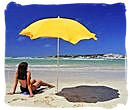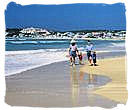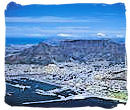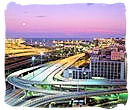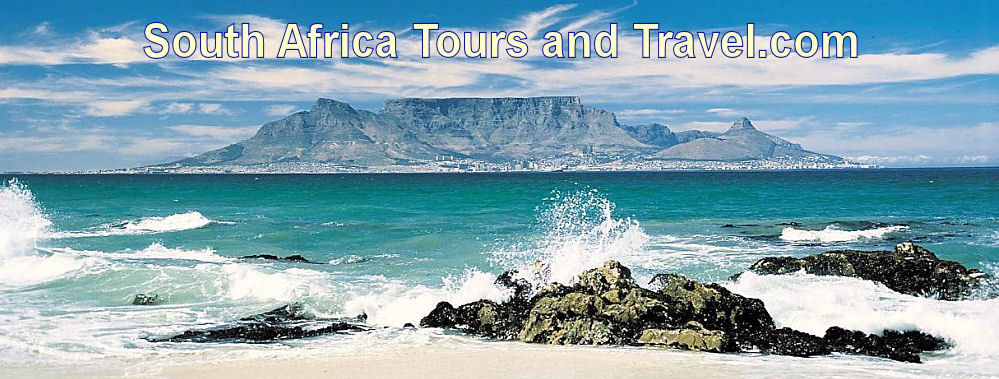 |
||||||||||||
The Karoo National Park in South Africa, |
||||||||||||
| GENERAL INFO |
| ACTIVITIES |
| ACCOMMODATION |
| FACILITIES |
| CLIMATE |
| HOW TO GET THERE |
| MAPS |
| ACCOMMODATION AVAILABILITY |
| TARIFFS |
| RESERVATIONS |
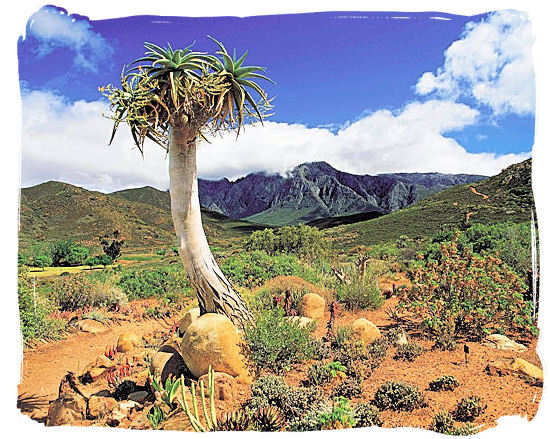
The unforgiving and yet so awesome and dazzlingly beautiful landscape of the Great Karoo
copyright © South African tourism
General info,...
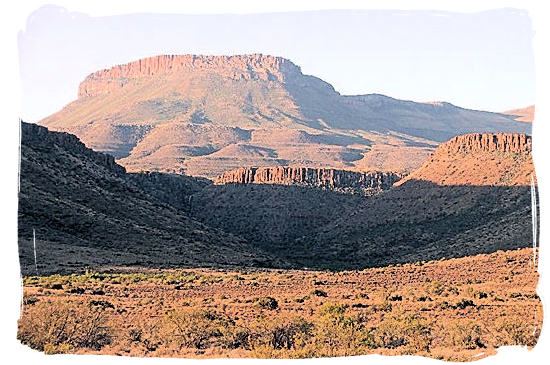
Landscape in the Karoo National Park
In ancient times the "Khoi" people herding their sheep and cattle and the "San" people following their traditional nomadic pursuits of hunting and gathering, shared the "land of great Thirst". In recent history, less then 200 years ago, vast herds of antelope and zebras roamed the rolling plains of the Great Karoo and the Karoo National Park.
Old "Voortrekker" stories about herds of Springboks so large that it took them days to pass, are not uncommon. But then the first white settlers arrived and the enormous herds were slowly but surely reduced to alarmingly low levels by hunting and farming activities.
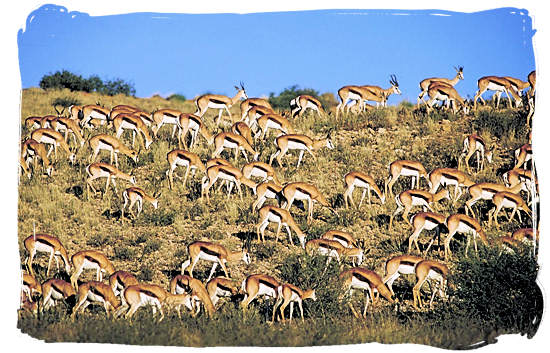
Large herd of Springbok (Springbuck) antelope, one of South Africa's national symbols
copyright © South African tourism
Driven by the urgent need to save and protect the rich fauna and flora in the Great Karoo region, a group of people led by a local farmer named William Quinton, started campaigning during the 1950s for a conservation area in the vicinity of the town of Beaufort West.
However, it was only in the 1970s that the South African National Parks organization proposed the establishment of a National Park. The Town Council of Beaufort West donated 7,209 hectares of communal land, which was the start of the Karoo National Park, proclaimed in 1979.
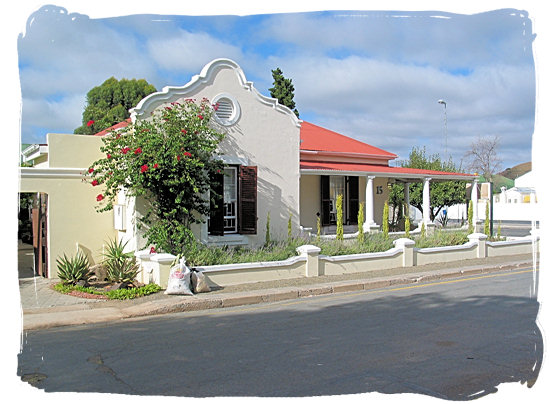
Historical Cape-Dutch style house in the town of Beaufort West
Photograph by Will Goodchild
The Karoo National Park is situated approximately 500km north-east of Cape Town and 1,000km south-west of Johannesburg. It lies quite isolated within the vast expanse of the Great Karoo.
The nearest town of any significance within a circle of roughly 100km of the Park, is the town of Beaufort West just off the N1 highway, about 12km away from the rest camp. The Park is a perfect stop-over en route between Johannesburg and Cape town or vice versa, an experience you do not want to miss.
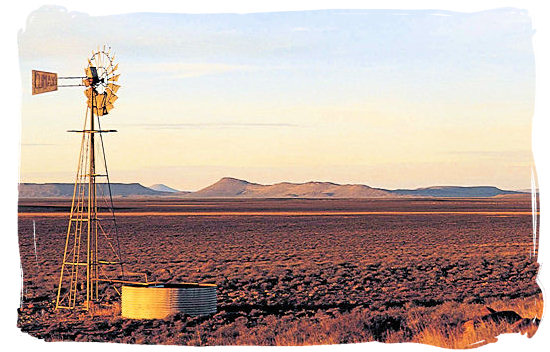
Lonely windmill near the town of Colesberg
copyright © South African tourism
As one of the world’s most unique semi-desert regions, the ancient and fossil-rich Great Karoo houses the richest desert flora in the world with Over 9,000 species of plants, including the largest variety of succulents.
This is three times more than in the whole of the British Isles. Examples of most of these can be seen within the National Park. The vegetation in the Park consists of four basic types: Dwarf Scrub, Grass, Trees and shrubs and Ephemeral vegetation.
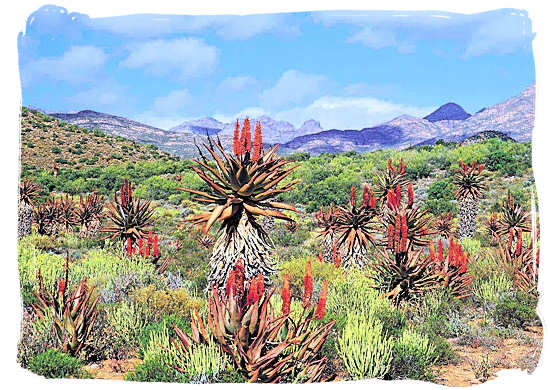
Aloes, one of the 9,000 plant species to be found in the "Land of great thirst"
copyright © South African tourism
Flowering time in the Park is sudden and brief, depending totally on the rainfall pattern, which is highly erratic. It is always a breathtaking sight when the dry semi-desert "veld" suddenly transforms into a beautiful rainbow coloured tapestry of flowers.
The "Kankerbos" with its beautiful red flowers, the "Klokkiesbos" with its pink bells, the Aloes with their brilliant red to orange hues, the common "Vygies" with there mauve, pink and white colours, and many more are all part of the sudden and brief flowering feasts in the Park.
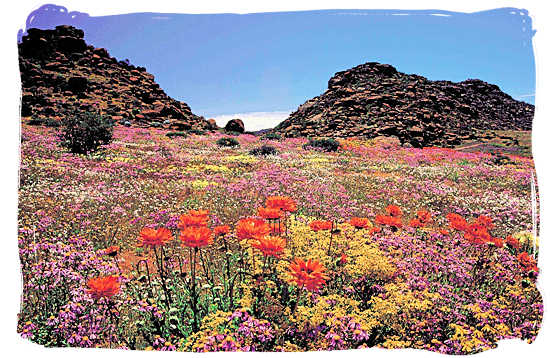
Flowering time in the "Land of great thirst"
copyright © South African tourism
Because of the sparse vegetation, game viewing in the National Park is absolutely wonderful. The Park is home to a large variety of indigenous game animals that have adapted to desert conditions. The rare Klipspringer is often seen on the pass of the same name.
Large herbivores such as Red Hartebeest, Black Wildebeest, Eland, two Zebra species, Kudu and Springbok are all also regularly seen. Other species are less obvious due to smaller size, nocturnal habits or restriction to the wilderness areas of the park.
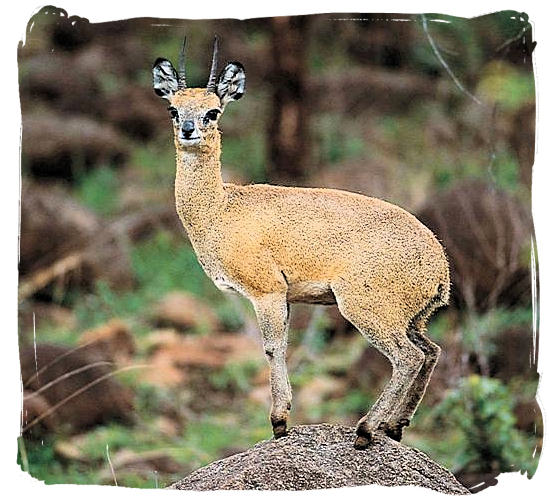
The rare Klipspringer, one of the smallest of the antelope species.
copyright © South African tourism
The beautiful Springbok, one of South Africa's national symbols, are present in large numbers in the Karoo National Park. Two of South Africa’s most highly endangered species, the riverine rabbit and the black rhinoceros, have been successfully resettled.
Efforts to bring back the Quagga, a species regarded as a member of the Zebra family, which became extinct on 12 August 1883, when the last female member of the species died in the Amsterdam zoo, have been showing more and more promise.
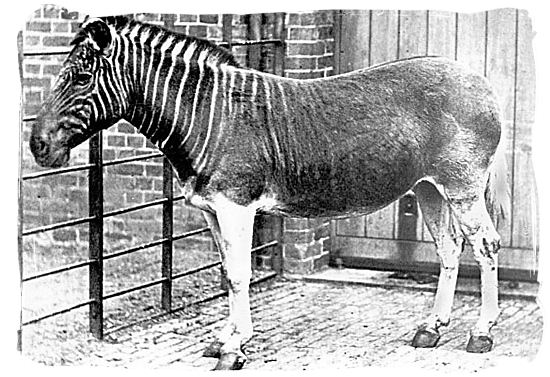
Black and white photograph of the last female member of the Quagga species
The most spectacular of the more then 200 bird species in the Park is the Black Eagle. More then 20 breeding pairs have made the Park their home. Other birds to be found in the Park are the Booted Eagle, Jackal Buzzard, Pale Canting Goshawk and the Rock Kestrel, to name but a few. Travel along the "Lammertjiesleegte" route for the best look-out points.
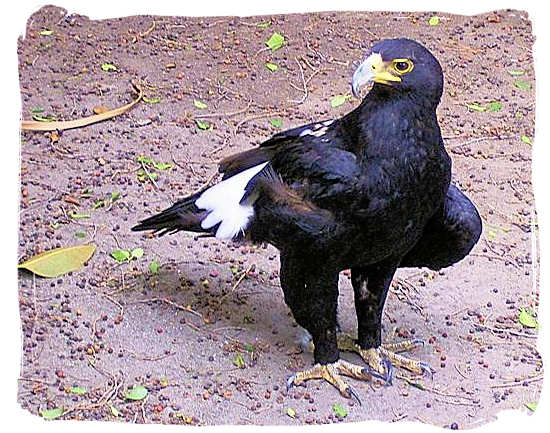
The African Black Eagle
copyright © South Africa tours and travel.com
Larks and Charts are prominent on the plains, where you should also look for the Karoo Korhaan, Ludwig's Bustard and Namaqua Sandgrouse. Some of the best birding occurs in and around the rest-camp site, where the Karoo Eremomela, Namaqua Prinia and Pririt Batis are regional specials to look out for.
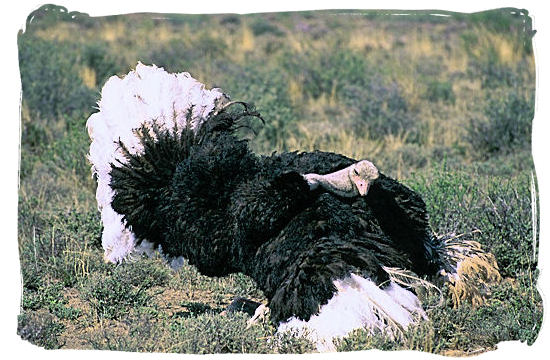
Male Ostrich performing his mating dance
copyright © South African tourism
In prehistoric times large mammals and amphibians such as the stocky Bradysaurus, the mammal-like reptile Lystrosaurus, the deadly predator Gorgonopsid and the plant-eating Diictodon used to roar and roam in the Karoo National Park.
Many fossils have been uncovered in the Park and its surrounding area. For those interested, the Fossil Hiking Trail in the Park is a good starting point to explore a display of superb examples of fossiled remains of prehistoric life in the Park.
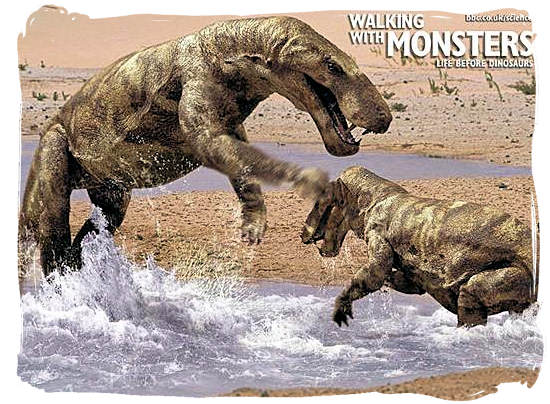
A screen shot from the BBC documentary "Walking with monsters", showing what the Gorgonopsid may have looked like - copyright © BBC
<< Top of Page
Facilities,...
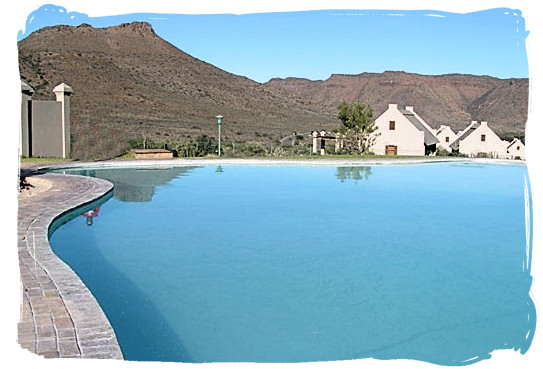
The lovely swimming pool at the Park's rest camp
Facilities at the National Park are excellent, comprising the following;
- Main (reception) building with an information centre.
- Shop that sells basic necessary groceries as well as a number of curios, handicraft and souvenirs, many of which are local to the area.
- Fully licensed a la carte restaurant with great food and excellent service. The traditional Karoo lamb as well as the game meat are just a few of the restaurant's marvellous dishes.
- Audio/Video room where one can watch wildlife movies or listen to the rangers talk about the fauna and flora of the Park and other parts of South Africa.
- Swimming pool for resident guests only, a great place to relax and refresh during the hot afternoons.
- Picnic, "braai" (barbecue) and ablution facilities for day visitors at the "Bul kraal" picnic site.
- Self-service Laundry with washing machine and tumble drier at the camping site.
- Fully equipped Conference centre.
- Public telephone.
<< Top of Page
Accommodation availability,...
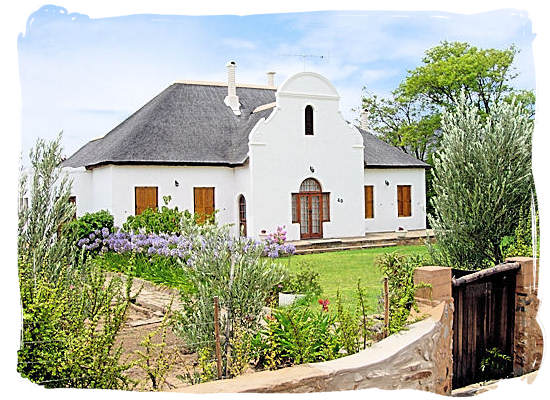
Typical Cape-Dutch style house in the town Beaufort West
Go to SANParks.org to view a monthly calendar with accommodation availability details of the Park on the South African National Parks organization’s (SANparks) website.
- If you click on the accommodation type, you will see the facilities and content of that particular accommodation unit.
- The accommodation code enables you to book a specific type of accommodation - if you provide it with your request for booking.
- The figure between the square brackets [ ] is the number of units at the specific time and date of visit to the accommodation availability page.
- Please note that the information is updated and therefore changing real-time on a continuous basis and that requests for reservations are processed on first-come, first-served basis.
Tariffs,...
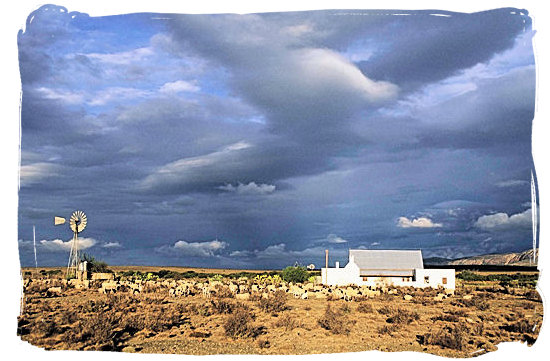
Sheep farm in the Karoo with one of those sudden and heavy thunder showers brewing
copyright © South African tourism
Go to SANParks.org to view the tariffs applicable for the Karoo National Park on the official tariff page of the South African National Parks (SANparks) website.
<< Top of Page
Reservations,...
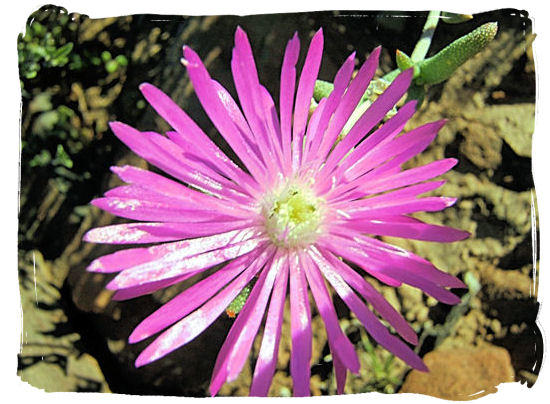
Karoo flower
Photograph by Tim Parkinson
Go to SANParks.org to book your reservation for the Karoo National Park on the official reservations page of the South African National Parks organization's (SANparks) website.
<< Top of Page
How to get there,...
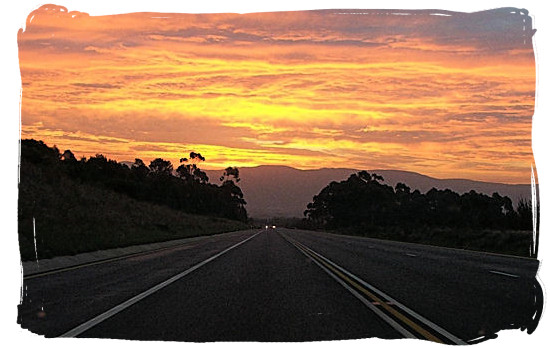
Sunset in the Great Karoo
By Air:
The International airport nearest to the Park is Cape Town, a distance of 462km. The nearest domestic airport is at George, a distance of 241km. Leaving you with considerable distances to travel by road, unless you charter a light aircraft to take you to a nearby landing strip for small planes.
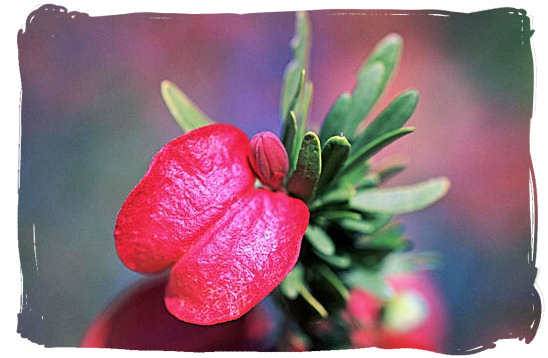
Succulent flower in the "Land of great thirst"
copyright © South African tourism
By Road:
The Karoo National Park is a convenient stopover on the N1 route between Cape Town and the interior of the country. Many visitors to the Park go there by car as this allows them the freedom to explore the Park at their own leisure.
The Park is situated 949km south-west of Johannesburg, 462km north-east of Cape Town and 241km north of George. All internal roads in the park are tarred, with the exception of the 4x4 Trail.
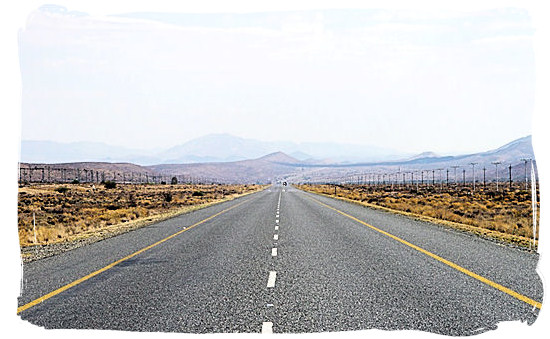
Seemingly endless road in the Great Karoo
Photograph by Damien du Toit
From Johannesburg or Cape Town is a comfortable drive on the N1 highway. The main rest camp of the Park is about 10km away from the town of Beaufort West which lies right next to the N1.
From George you travel just as comfortable with the N12 highway which joins the N1 just before you get to Beaufort West. The speed limit on our highways is set at 120km per hour.
Top of Page
